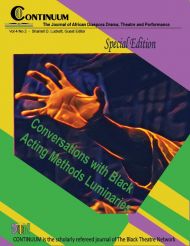Fela! – A Review. National Broadway Tour
Sharrell D. Luckett, PhD.
FELA! By Bill T. Jones, Jim Lewis & Fela Anikulapo-Kuti. Directed by Bill T. Jones. The Fabulous Fox Theatre, Atlanta, GA 2013.
On November 23, 2009 a provocative new musical based on the life of revolutionary Nigerian artist/activist Fela Anikulapo-Kuti played on Broadway. From 2011 to 2013 this musical toured globally. FELA! garnered eleven Tony nominations, winning three: Best Choreography, Best Costume Design, and Best Sound Design. Through the use of captivating images and a book and lyrics that supplied unflinching details of a life of political struggle, FELA! captured the relentless political stance of a revolutionary leader, heightening the production's political impact and relevance.
This musical biography neither obscures nor sugarcoats Fela's life and legacy. Fela’s biography sequentially unravels through his solo narration, through text projected on an upstage screen, and through the performance of his socially conscious songs. The musical opens in 1978. The audience finds itself in The Shrine, Fela's night club in which he created the distinct style of music known as “Afrobeat,” arguably the most important remnant of his artistic legacy. Brought to life by Antibalas, a New York Afrobeat band directed by Aaron Johnson, Afrobeat is a rich mixture of big band jazz, soul, funk, and West African sounds noted for lengthy arrangements, syncopated rhythms and call and response sections. With sensual finesse, dancers doubling as Fela's wives and background vocalists enter from the wings and through the auditorium chanting "daa da doo, daa da doo, da da doo." With both hands raised in iconic "black power" fists, Fela enters the Shrine and exhorts the audience to join in, urging everybody to shout "Yaay Yaah," successfully recruiting the audience, in effect, to become citizens of Nigeria who oppose the corrupt government.
Projection designer Peter Nigrini and scenic/costume designer Marina Draghici immediately introduced the audience to Fela's political struggle and linked it to struggles closer to home by utilizing still projections consisting of "black power" themed images and quotes. Posters bearing slogans like "Help find me a job in Nigeria" were juxtaposed with images of civil rights activists such as Malcolm X, Kwame Nkrumah, Muhammad Ali, and Angela Davis, all kindred revolutionary spirits who influenced Fela's political platform. One of the most powerful and inspiring images, and one that Fela (played by Duain Richmond) gazed upon in reverence throughout the evening, was a glowing, shifting hologram of Fela's mother, Funmilayo Ransome-Kuti, who served Nigeria as a civil rights activist and was also a major supporter of Fela.
Between Fela’s politically charged commentaries, the candid impact of his revolutionary activism was most powerfully manifested through his music which invited the audience to confront issues like public mind control (Zombie), state-sponsored dissemination of false information and history in schools (Teacher Don't Teach Me Nonsense), and other local and global illegal governmental practices (I.T.T./International Thief Thief). Fela describes the development of his own compound called the Kalakuta Republic and writes a song about the assaults and torture he, his 27 wives and other compound residents suffered at the hands of soldiers (Sorrow Tears and Blood). We learn about his abandonment of medical schooling in London to become a musician, his time in prison on dubious charges, his failed attempt to run for the Presidency, and his trip to America in which he encountered the influential Black Power Movement and Afrocentrism (Upside Down). During Upside Down, Michelle Williams, formerly of Destiny's Child, delivers a sultry vocal and physical performance of Sandra Izsadore, Fela's pivotal mentor and love interest. During Act II, Fela shares that his mother died after being thrown out of his compound window by soldiers. In response to this horrific incident, Fela delivered his mother's coffin to the Nigerian government and wrote the song Coffin for Head of State. This song was performed after the audience witnessed the climax of the musical in which Fela seeks guidance from his deceased mother in a Nigerian ritualistic ceremony that allowed her spirit to possess a priest. As the evening concludes, slide projections depict Fela's death in 1997 and the one million mourners who attended his funeral. The somber mood, however, is transformed into a celebratory one when Fela reprises the popular musical number, Kere Kay, a rousing chant-based song garnering a standing ovation.
FELA! introduces Fela Anikulapo-Kuti's legacy without compromising his political integrity and beliefs. The struggles and harsh facts of his life are laid out for audiences, employing Afrobeat as a tour guide into Fela’s reasoning and actions. Ultimately, when I left the theatre, I experienced an exhilarating baptism into a musical world of pain and triumph, and was grateful that Broadway had recognized and exalted a deserving prophet. In an era when injustices still abound, it is fitting to pay homage to an icon who promoted equality, using music as his most powerful weapon.


